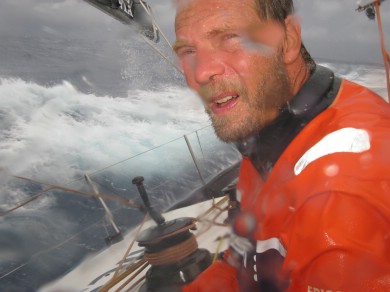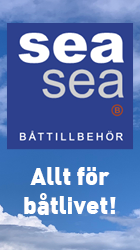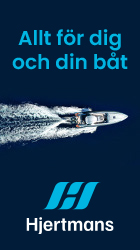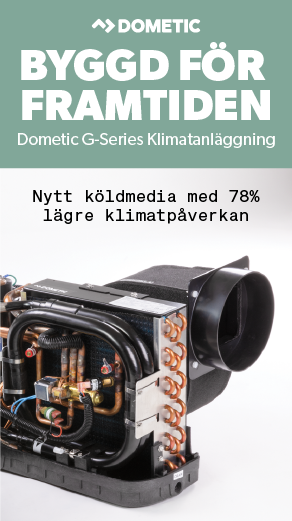Det ärextremt jämnt i ledningen för Volvo Ocean Race efter cirka en tredjedel seglat av etappen mellan Kina och Brasilien. Efter ledande Ericsson 4 ligger Ericsson 3, Puma och Telefonica Blue alla tre samlade inom 2 Nm. Med cirka 8 500 Nm kvar till etappmålet i Rio kanvad som helst hända.
Här är den senaste pressreleasen från Race Office:
leg Five Day 12 Daily Story: Violent Squalls Bring Big Gains And Losses
Posted: 25 Feb 2009 07:55 AM CST
All five boats racing down the South Pacific Ocean in leg five of the Volvo Ocean Race are engaged in a battle with nature. The doldrums and the associated clouds and squalls are causing big gains and huge losses across the fleet as the boats get pushed further away from their optimum courses by the unstable weather.
“It’s all about your route through the cloud minefield,” says Guy Salter from Ericsson 4 (Torben Grael/BRA) who is clinging onto first place. “Often you just can’t avoid them [the clouds], and have to accept that, several miles away, your competitor is having an easier time of it,” Salter explained, as the team looks over its shoulders to see PUMA (Ken Read/USA) and Ericsson 3 (Magnus Olsson/SWE) 26 nm astern and gaining.
According to Salter, the clouds have often left Ericsson 4 in a complete void without even a breath of wind, before suddenly sending down a squall with such speed that the team has often found itself a fair way off their optimal course, and has been pushed further south than they planned.
With clouds, come big gains and losses. Two days ago, Ericsson 3 (Magnus Olsson/SWE) sailed into PUMA’s world and has been their constant companion ever since.
“We then started a 48-hour flat out drag race and slowly pulled out a very hard-earned four-mile lead, only to have it evaporate late last night in one squall,” explains PUMA’s skipper Kenny Read.
“We slowed to 11 knots, they came roaring up at 20 and it has been game on ever since,” he said. At 1300 GMT today, PUMA had regained a marginal upper hand and is in second place. Both boats gybed onto a southerly course just after 0930 GMT this morning and are split across a lateral divide of 6.5 nm west to east, and making about five knots.
The squalls in this region appear to be quite prevalent, and can last up to two hours. The first signs of a vicious squall approaching is a general darkening of the sky and a thickening of the clouds to weather of the boat. The leading edge of the squall is accompanied by a high probability that there will be a significant wind shift.
Rick Deppe says that when they observe the high black cloud, light rain starts to fall which lasts for about five minutes. It is generally followed by a short pause in the rain, which may be accompanied by possible clearing of the clouds. “The break will only be for a few minutes before the large drops start to fall from the puffy nimbus clouds that make up the body of the squall,” he says. These conditions are likely to last for at least another three days as the fleet picks its way towards Fiji.
“Once the call has been made that we are about to get hit [by a squall], the crew has to react quickly to make the boat safe – wind speeds in a squall can easily double or increase by 20 knots. The squalls generate a sloppy wave pattern and the boat starts to crash and bump because the waves are disorganised and random, “explains Deppe.
Making the most of the conditions and very much back in the game is Ian Walker’s Green Dragon. The team is 86 nm to the east of Ericsson 4’s track and averaging a steady 13.5 knots.
“The fleet has opted to follow our easterly route, which has consolidated some very big gains for us,” said Ian Walker who celebrates his 39th birthday today. “We have taken over 200 miles out of the leaders and are very much back in the hunt. It looks like everyone is shaping up to go east of Fiji, where a large area of no wind awaits the fleet,” he said.
Telefónica Blue (Bouwe Bekking/NED) is in fourth place, but closing quickly and averaging 10 knots of boatspeed. Bekking is still playing it conservatively, following the pack and not making any radical decisions. Their track takes them 84 nm west of the tracks of PUMA and Ericsson 3.
“Our boatspeed over the last few days has been really good and we feel that if we can get into the same patch of water as the others in this light to moderate reaching, then we will do well, “ said navigator Tom Addis. The team is happy to follow the leaders down to the first scoring gate at 36 degrees south, where they expect a restart with the fleet.
Although the fleet continues to battle with all that nature can throw their way, occasionally the wind Gods smile and clouds arrive at just the right time to give a real boost in the right direction.
“Breeze picking up now – 14 knots of boats speed, and, by the look of this cloud, it is lined up quite nicely for us and we should get quite a nice run out of it for 10 miles or so. Nice, friendly helpful, benevolent, thoughtful cloud…” wrote Tom Addis from Telefónica Blue at 0705 GMT today.
Leg Five Day 12: 1300 GMT Volvo Ocean Race Positions
(boat name/country/skipper/nationality/distance to finish)
Ericsson 4 SWE (Torben Grael/BRA) DTF 8,830 nm
Ericsson 3 SWE (Magnus Olsson/SWE) +26
PUMA Racing Team USA (Ken Read/USA) +26
Telefónica Blue ESP (Bouwe Bekking/NED) +62
Green Dragon IRL/CHI (Ian Walker/GBR) +88
Delta Lloyd IRL (Roberto Bermudez/ESP) DNS
Telefónica Black ESP (Fernando Echávarri/ESP) DNS
Team Russia RUS (Andreas Hanakamp/AUT) DNS
Länk: www.volvooceanrace.org
Här är Ericsson Racing Teams senaste pressrelease:
ERICSSON 3 CREW MOVES INTO TIE FOR SECOND PLACE
STOCKHOLM, Sweden (Feb. 25, 2009) – Leg 5 of the Volvo Ocean Race began on Feb. 14, but for Ericsson Racing Team’s Nordic crew the leg began three days earlier when the sailors set off from Taiwan on their yacht Ericsson 3 bound for the finish of Leg 4 in Qingdao, China.
Today marks the crew’s second week at sea, save for two hours when they docked in Qingdao to load food, fuel, gear, spares and additional crewmembers, including two new faces, for the leg. Today, they’re reaping the rewards of focused diligence.
At today’s 1309 GMT position report, Ericsson 3 was tied for second place with Puma of the U.S. Both boats trailed fleet leader Ericsson 4 by 26 nautical miles.
Ericsson 3 and Puma’s il Mostro were separated by about 8 nautical miles and have been racing in close quarters since last weekend. Puma had held the upper hand until last night, when Ericsson 3 got by to windward in light conditions. The fleet is contending with the South Pacific convergence zone, an area of unsettled weather.
“We are still in the tricky Doldrums fighting closely with Puma,” said Ericsson 3 watch captain Thomas Johanson. “The wind and weather is changing extremely quick in this convergence zone and the wind just went from 10 to 30 knots. It was really what we call a [tough] fight, but we handled it well and actually overtook the il Mostro.”
A pre-race goal of the Nordic crew entry was to give offshore experience to a group of sailors who are solid in their own right, having backgrounds in the America’s Cup, Olympic classes and other grand-prix sailing, but had never done a circumnavigation race. Many of the crewmembers were picked by skipper/watch captain Magnus Olsson, who’s competing in his sixth Volvo Ocean Race.
“I thought we would have bigger problems with Puma and Ericsson 4. They are a little bit faster than us in these power-reaching conditions,” said Olsson, who was named skipper during the stay in Taiwan.
“I think we’ve done well,” Olsson continued. “We weren’t as well rested as we should’ve been because we fixed the boat and came late for the start and it was a big drama and everybody had the mindset we had to finish Leg 4 before we could start Leg 5. So it wasn’t ideal, but I’m very, very happy with where we are. It couldn’t have started better for us.”
There have been other changes to the crew list. Johanson, the primary helmsman on the initial legs, became a watch captain when Richard Mason had to stand down for this leg due to an injury concern.
Two other crewmembers were also added for Leg 5, Arve Roaas of Finland and Magnus Woxen of Sweden, who have previously raced in the Southern Ocean.
Their experience is welcome as seven of the 10 active crewmembers and the media crewman are participating in their first circumnavigation race.
“I would say we are a bunch of very different guys but with same determination, winning spirit and never-give-up-attitude,” said Johanson. “We are all on a mission and trying the best ever we can to show ourselves we can do this race. Well, not only to finish,but to be on the podium. We have the talent but not the experience. Gladly we are fast to learn.”
Of the remaining crew, there has been a shuffle of responsibility. Jens Dolmer, the boat captain, pitman and former farmer, has become backup to navigator Aksel Magdahl, the youngest navigator in the race. Johanson describes Dolmer as the boat’s “heart and soul.”
“He likes to be close to the nav desk, so he is now working as a floater and is Aksel’s backup, but also as our pitman,” said Johanson. “He surely is a workhorse who’s always checking the systems and [pushing] others to try to get to his level on their different responsibility areas.”
VOLVO OCEAN RACE LEG 5 LEADERBOARD
(Feb. 25, 2009, 1309 GMT)
1. Ericsson 4, +8,830 nautical miles to finish
2. Ericsson 3, +26 NM
2. Puma, +26 NM
4. Telefónica Blue, +62 NM
5. Green Dragon, +88 NM
Bilden:
Thomas Johanson på Ericsson 3. Foto: Gustav Morin/Ericsson Racing Team.







